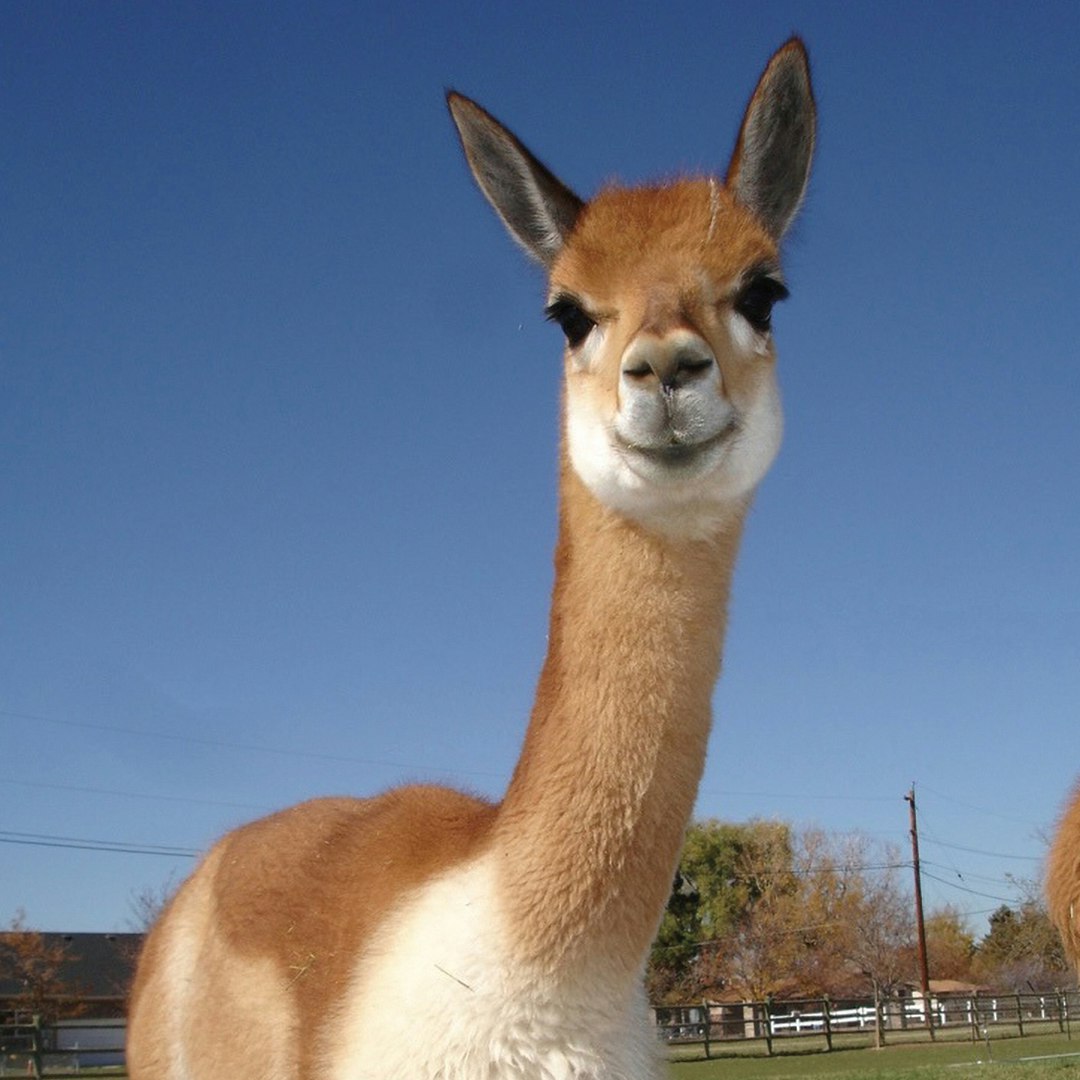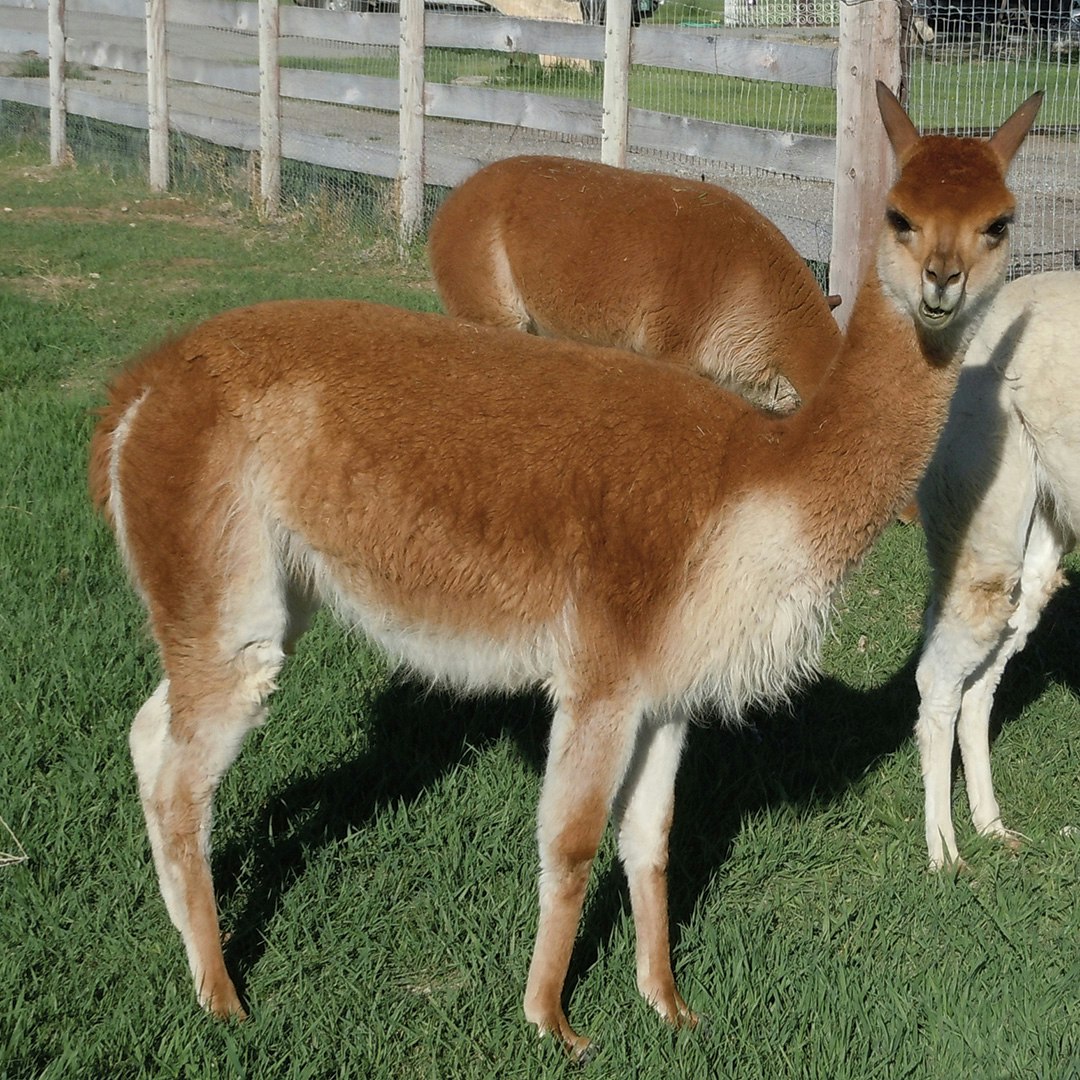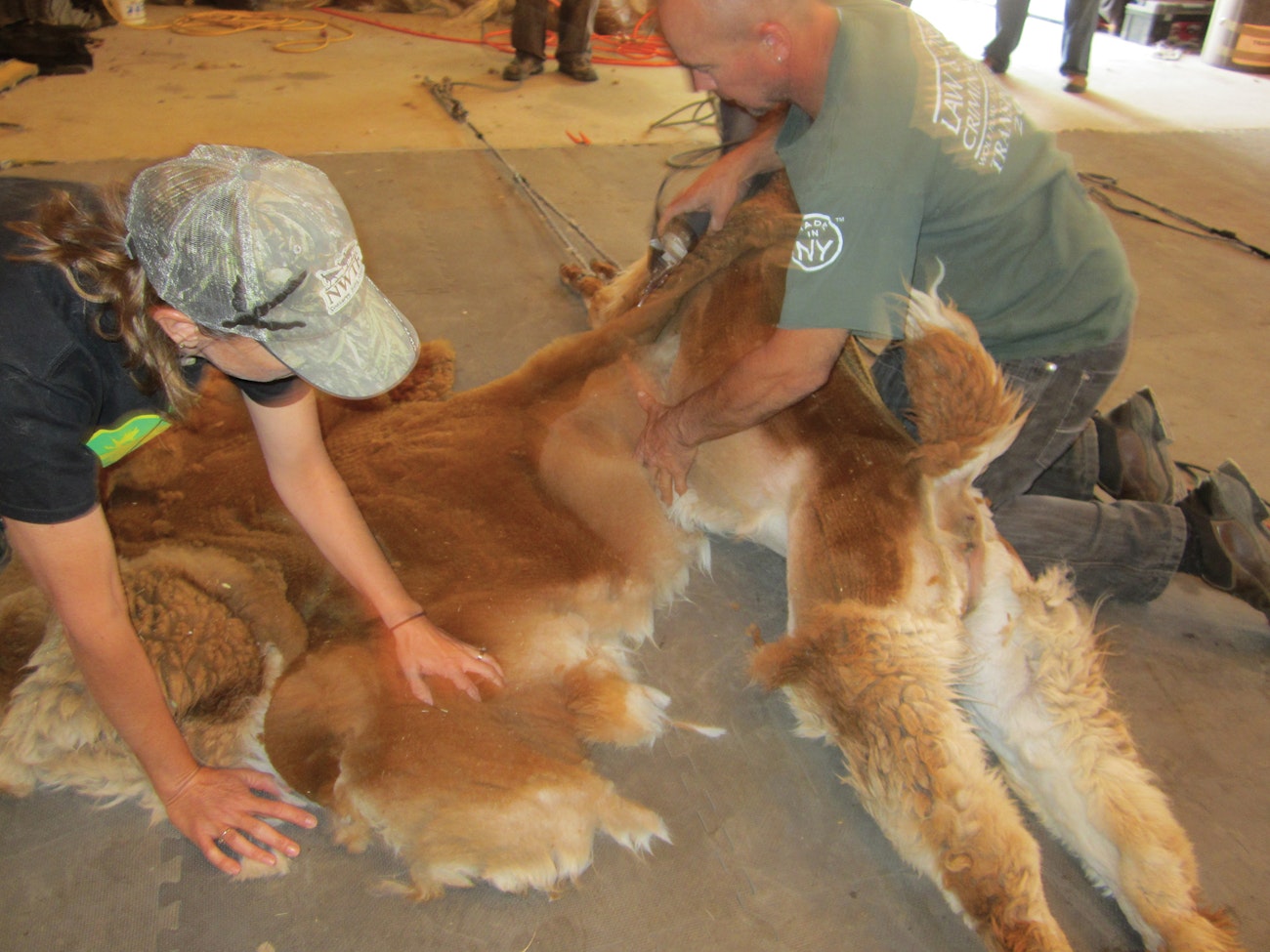What happens when you blend a practical-minded woman seeking to better manage an overflow of responsibilities and a fortuitous patch of land near Denver, Colorado? You get Jefferson Farms, a rare-alpaca farm where founder Jane Levene’s pragmatic nature helps her produce some of the finest spinning fibers money can buy.
Now if, like many wool lovers, you think you’re not much into alpaca, do read on. The paco-vicuña (PV) is not your ordinary camelid. As the Paco-Vicuña Association explains, PVs in North America “are domesticated camelids selectively bred to exhibit the best fiber traits of their wild vicuña ancestors.”
One of the results of this focus on vicuña characteristics is a deliciously soft fleece that earns PVs a place in the elite category of rare luxury fiber. Jane is more than willing to bet the farm on this fact. “I would put PVs against musk oxen in a heartbeat,” she says, citing the PV’s better range of natural, often reddish and deep mahogany colors, its longer and easier-to-spin staple, and the breed’s ultrafine micron count.
Through her meticulous flock management, Jane has sought to improve upon this already opulent, top-of-the line fiber. She envisions PVs whose fleece characteristics share the proverbial spinners’ spotlight with the finest and crimpiest wools. In the meantime, Jane works on her daily goals: to cultivate a lushly dense, uniform, ultrafine fiber and to continue finding ways to make her living doing so.
 Alpacas and their paco-vicuña relatives are said to be as sweet as they look—especially in baby (cria) form, as seen here. Photo by Jane Levene
Alpacas and their paco-vicuña relatives are said to be as sweet as they look—especially in baby (cria) form, as seen here. Photo by Jane Levene
Family First
Jane wasn’t looking for an agricultural career in 1995 when she found what would become her family’s 5½-acre spread near Denver, Colorado. All she really wanted was to make better use of her time and energy as a full-time working mother who was at the same time caring for her aging parents. She set out to find enough land to support two distinct houses—exactly what the Denver property title offered. It also came with one more, unexpected, bonus: the property had been zoned with an A-1 farm tax status. This difficult-to-attain, use-it-or-lose-it classification allowed for ranching and farming. The property also included water rights (a major and complex environmental responsibility in the state of Colorado).
Ever the pragmatist, Jane was not about to let this much-coveted status go to waste.
Surprisingly, the family venture into alpaca farming came quite accidentally. Jane’s mom had seen a sign advertising alpacas for sale, and so they bought a couple. Soon these became 40, then more, and the extended Levene clan—especially Jane’s dad, who worked outside on the farm with his daughter every single day until his death at age 90 in 2016—was happily ensconced in the alpaca business.
But the quality of alpacas’ fleeces varied dramatically during this time period due to a lack of quality control within the breeding community itself. Jane was concerned that as the family’s animals aged (alpacas can live 15 to 20 years) their fleeces coarsened or were too varied in fineness for consistent pricing and profit. “We wanted to have animals that could hold their fiber value better so that we could charge an appropriate price throughout the animals’ life span,” she says.
There were also sobering ranch, life, and environmental realities to consider. The problem was, the Levene family loved the docile, sweet-looking species, and they wanted to make an alpaca business work.
What Jane needed was an alpaca with a lifelong, consistently low-level micron count—all the better if the fiber length could be in the spinning (and milling) sweet spot of 3 to 4 inches. Better still, what if this fantasy fiber could also include the elasticity her alpaca was lacking? Now that would be perfect, especially if the animal retained the amenable disposition for which it is known.
Enter close friend Chris Switzer, whose flock of the incredibly rare North American paco-vicuñas would change the direction of Jefferson Farms.
 One sign of a premier (Type I or II) paco-vicuña is its protruding eyes—a trait acquired from its vicuña ancestors. Photo by Jane Levene
One sign of a premier (Type I or II) paco-vicuña is its protruding eyes—a trait acquired from its vicuña ancestors. Photo by Jane Levene
Introducing the Paco-Vicuña
Now, Chris Switzer is quite the expert on PVs. She should be, as she and her husband, Phil, are responsible for the ingenious idea and Herculean task of bringing the breed to North America back in 2002. With the idea of selectively emphasizing the sweet temperament, plush fiber, and long staple of the domesticated alpaca along with the downy softness and high fiber curvature (the measurement of fiber memory/elasticity) of the endangered and still wild vicuña, Phil and Chris traveled through the Andes, finding just the right genetically inclined alpacas—those with wild vicuña traits—to bring home to Colorado. The results were all they’d hoped for. Phil then worked on creating the PV’s grading standards as well as a national registry to help maintain clean heritage and breed statistics.
PVs are a more primitive type of alpacas. They are of a rare and unique caliber, with a price to match: depending on the level of preparation and grade of fineness, expect to pay $35 to $75 per ounce for fiber.
Jane recognized the potential of this breed immediately and fine-tuned her own business direction. Taking the risk even further, she convinced her physician husband, Arthur, to allow her to turn their fishing cabin in Salida, 100 miles away, into the hub of what would become the business’s main ranch.
 In addition to its plush coat, the paco-vicuña is also identified by its white bib. Photo by Jane Levene
In addition to its plush coat, the paco-vicuña is also identified by its white bib. Photo by Jane Levene
Today, the Salida property has grown to 90 acres. Between the two farms, there are over 400 hundred PVs. Their fiber, whether sold as mill-processed roving from a select number of fleeces or processed into yarn, is the main income of Jefferson Farms. The business also offers siring services, sells alpacas and PVs to interested and qualified shepherds, provides counsel and training on all things PV, sells rabbit meat, and offers two vacation rental homes on the Salida property (where interested parties can take a farmcation). According to Jane, it’s vital to have as many streams of farm income as possible, all at the same time.
In 2018, there were 50 animals, including crias (baby alpacas) born at Jefferson Farms. There have been 45 new births to date in 2019, and in 2020, Jane forecasts 75 more. With a medical background, Jane herself handles all labor and delivery and most other medical-based animal needs.
Getting Particular
North American paco-vicuñas are graded by fiber fineness, ranging from Grade 000 (11–12.99 microns) on up to Grade 3 (23 microns and higher). One of the prime advantages of the PVs is the ability to maintain this incredible fineness throughout their lifetime. Jane states that one of their working studs currently maintains a 12.7 micron fleece even at nine years of age! The finer the fiber (graded in lower numbers), the denser the blanket of fleece itself. In fact, these fleeces are often sheared in one piece, coming off the animal “just like a pelt,” says Jane.
The PVs displaying more vicuña-like characteristics are sheared every other year to obtain the desired 3- to 4-inch staple length. Shorter than that and the fiber can be challenging to spin, sacrificing its sheen in woolen-draw options; longer than that and the combination of length and plushness can cause problems with the milling equipment during processing.
Per the requirements of the Paco-Vicuña Association, the registry founded by Phil Switzer to maintain the integrity of the registered North American PVs, a micron/density sample is pulled from every single animal when it is sheared at every shearing regardless of age of the animal. Each animal’s sample is sent to Yocom-McColl Testing Laboratories, Inc. for micron testing, where it is also tracked for staple length and curvature. Jane says, “This fiber data is in turn submitted to Colorado State University for a comprehensive EPD (expected progeny differences) program, analyzing up to five genetic traits in this national herd. As a new breed, the association felt it was imperative to accurately track and analyze the outcome of each and every breeding. The goal of this effort is to make PVs the most thoroughly documented breed of fiber-producing livestock.
PVs have unusual uniformity of staple length and fineness of fiber within each animal’s fleece, although there is some variation of these traits among flocks.
Through careful breeding, Jane has easily attained a fineness of less than 18 microns across her own flock. She is now well on her way toward her goal of 16 microns or less across the entire flock with many in the herd maintaining a micron of 12–14, regardless of their age.
 Shearing at Jefferson Farms. Photo by Jane Levene
Shearing at Jefferson Farms. Photo by Jane Levene
Paco-vicuña is an ideal fiber for handspinners. As Jane explains, the crinkle, or tiny, unorganized crimp, helps to interlock the fibers, creating that loft so many of us love. Its memory makes for an easier twist introduction than one finds when spinning most modern domesticated alpaca. Its uniformity of staple and softness make for fiber so plush that the eye almost can’t recognize where one fiber begins and another ends. Despite the PV’s cost, the airiness of the fiber helps to maximize yardage, particularly when spun into a laceweight yarn.
Despite her unintended foray into alpaca farming, Jane wouldn’t choose any other life. “There’s something about a farm that people love,” she says, noting how nieces and nephews, grandkids, and even strangers have always loved to visit. Her initial idea of finding land to house her family and her parents turned out to bring them—and others—together in beautiful, extended, and unforeseen ways.
There’s only one thing she’d change, and that’s how people view alpaca as a fiber so distinctly different from wool, when both are spinning-friendly and come in a vast range of grades. “There should be a more uniform language. We don’t need to be different.”
Maybe that’s what Jane will work on next.
What is Paco-Vicuña?
The South American vicuña is a protected species and cannot be imported into the United States. So, how was the North American paco-vicuña developed? The Colorado-based Switzer family, who initiated the development of the North American PV, states that the breed was established “by identifying the various traits of vicuña in alpaca and selecting the alpacas with [those] traits. These alpaca (paco-vicuña) can be bred together to amplify the vicuña traits, such as low micron count, bib [markings], and color, and produce a superior paco-vicuña.
“The same can be done for the desired traits we want for the paco-vicuña from the alpaca, such as fast-growing fiber and calm demeanor. The key is to recognize the alpacas that have these special traits and breed them together to magnify the qualities we are looking for in a paco-vicuña.” (See Resources below for more information.)
Interested in learning about more exotic fibers? This article and others can be found in the Winter 2020 issue of Spin Off.
Also, remember that if you are an active subscriber to Spin Off magazine, you have unlimited access to previous issues, including Winter 2020. See our help center for the step-by-step process on how to access them.
Resources
- Jefferson Farms Natural Fibers, www.jeffersonfarmsnaturalfibers.com.
- Robson, Deborah, and Carol Ekarius. The Fleece and Fiber Sourcebook. North Adams, Massachusetts: Storey, 2011.
- Switzer-Land Alpacas, Chris and Phil Switzer, www.alpacaland.com.
- North American Paco-Vicuña Association, www.pacovicuna.com.
Deborah Held is a freelance writer and a full-time, real-life spinster. She blends wool and words, sharing with others the positive impact that daily handspinning and her commitment to it have brought to her life. She lives somewhere in Atlanta in a sun-filled lair, where her desk and her wheels all sit facing a spinner’s flock of sheep.
Originally published April 29, 2020, updated December 12, 2022.

